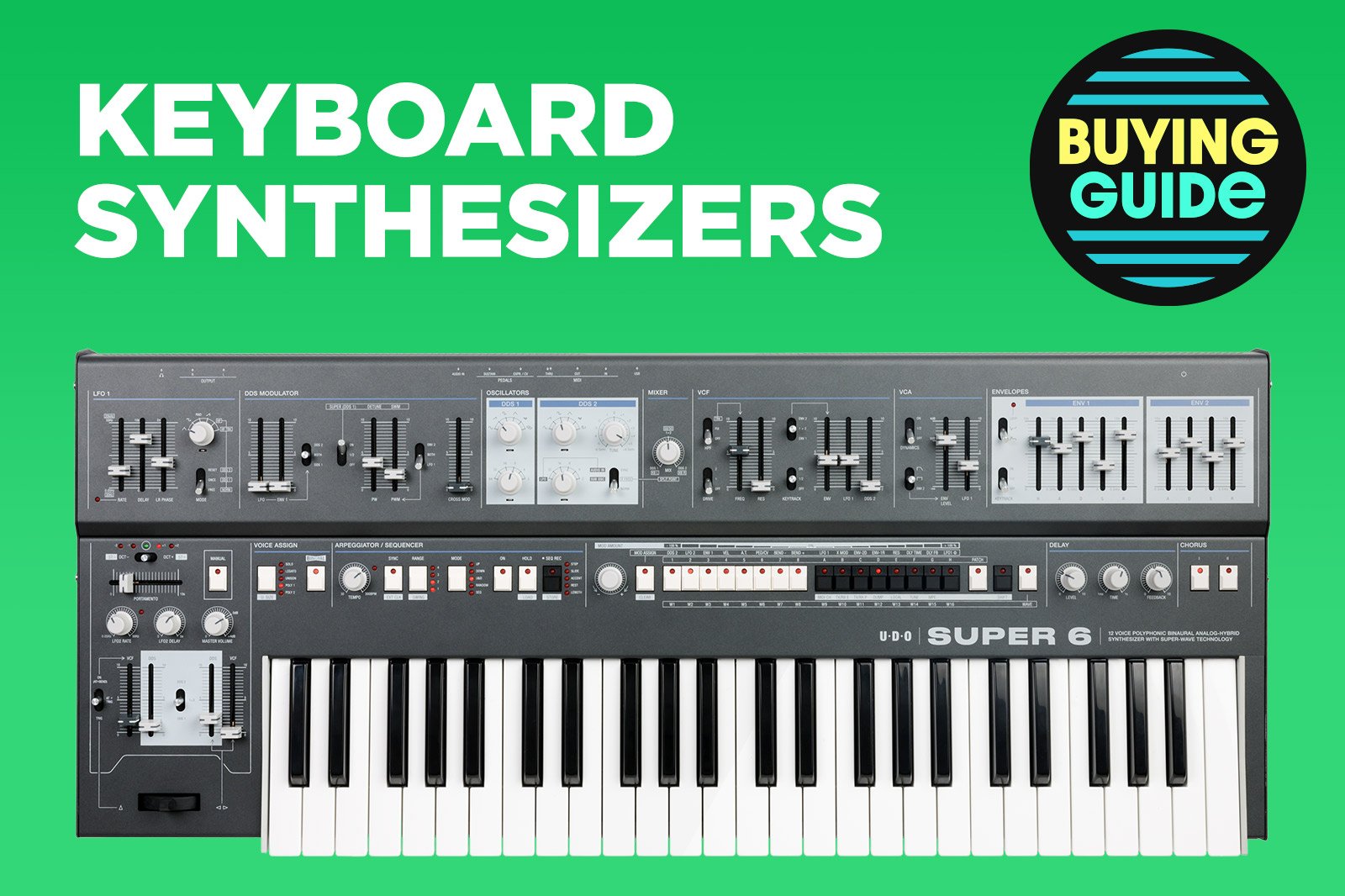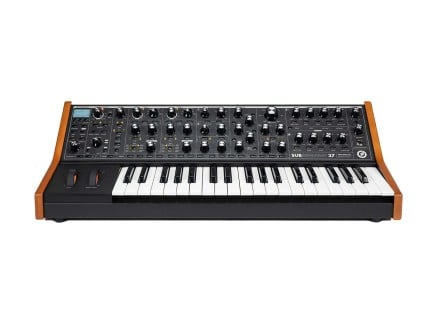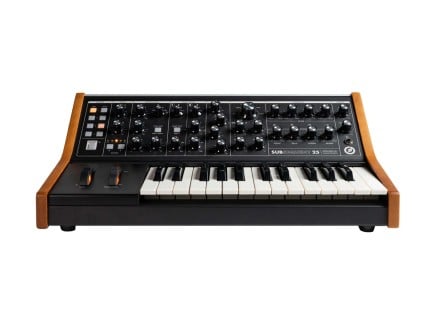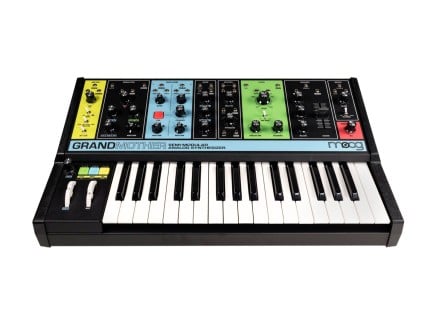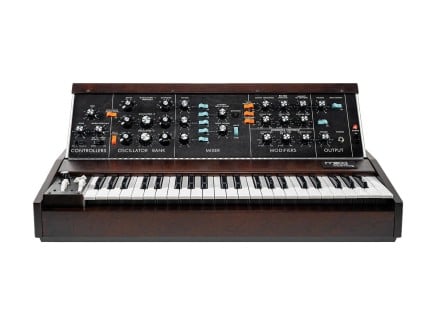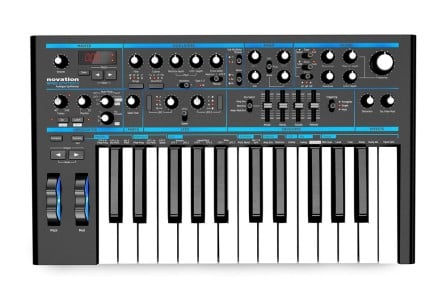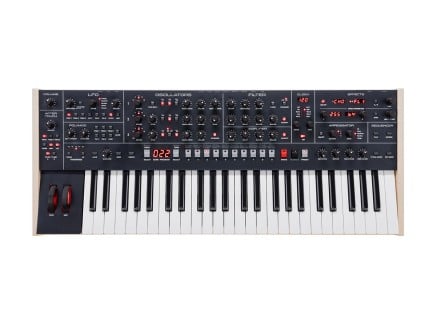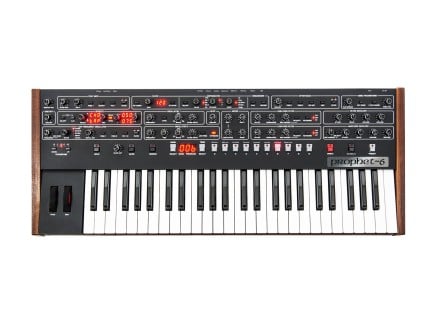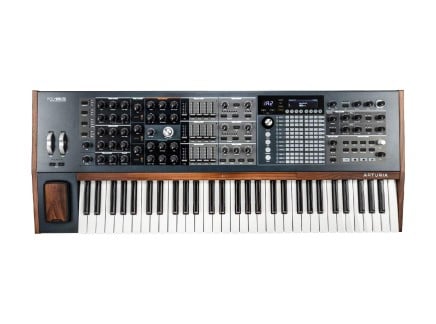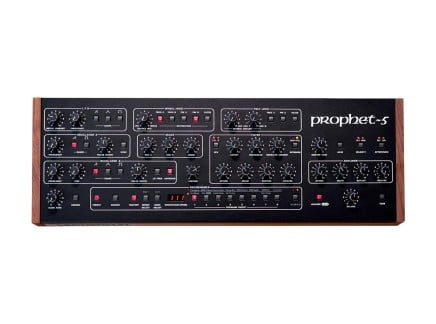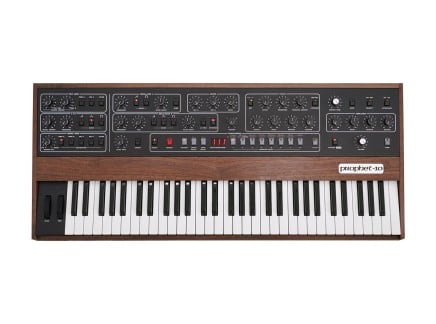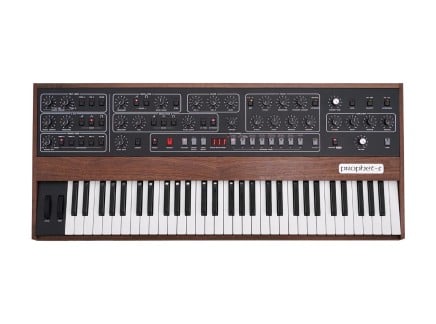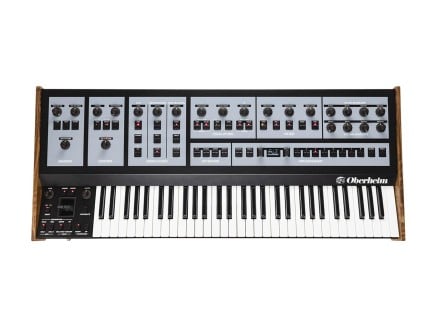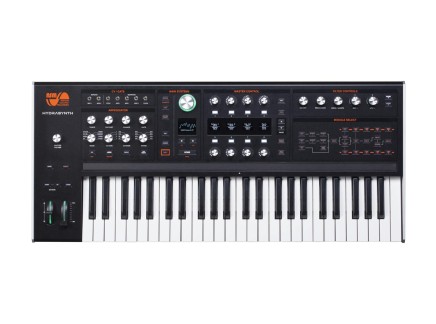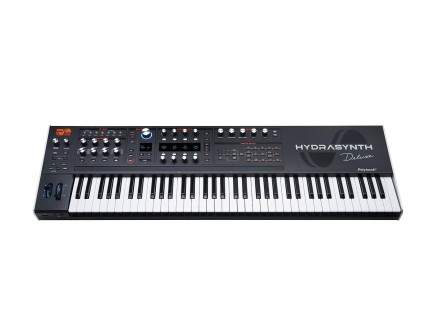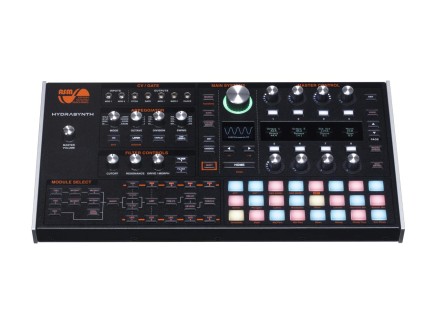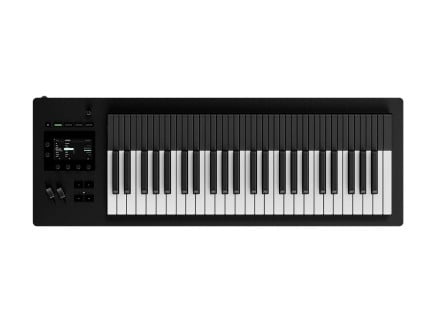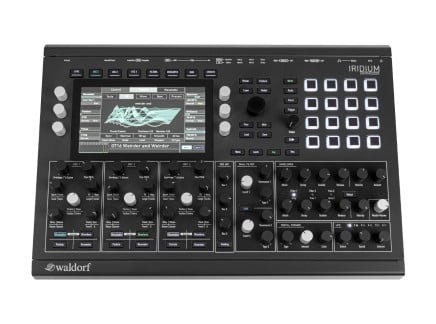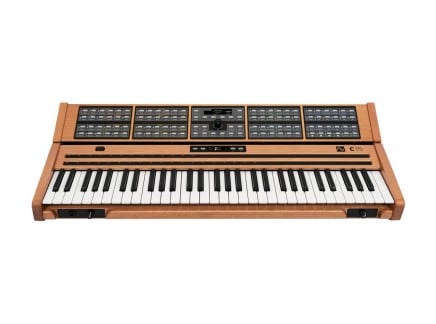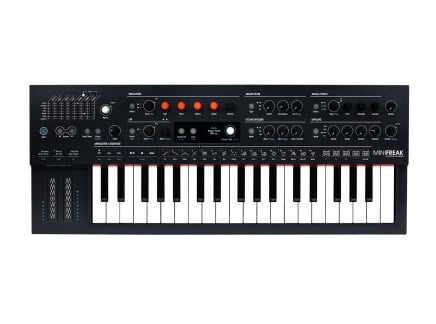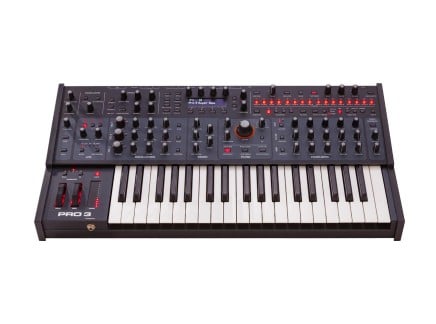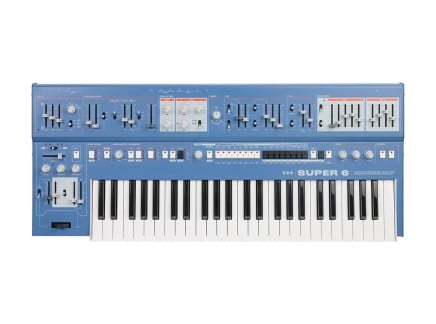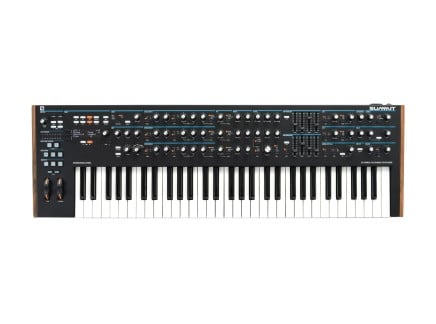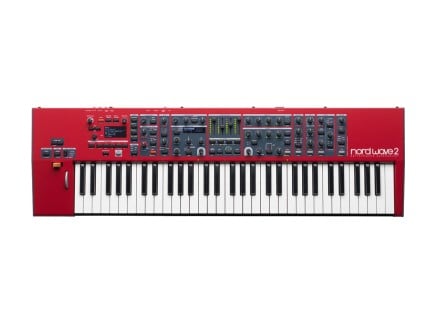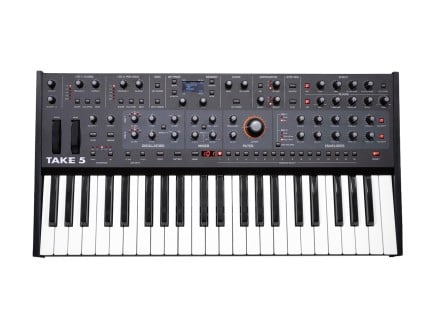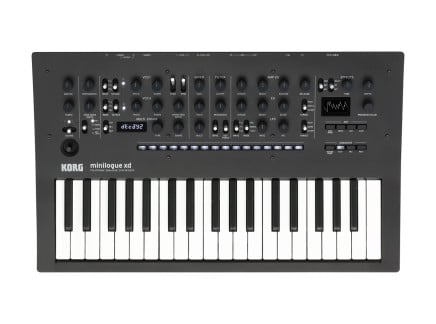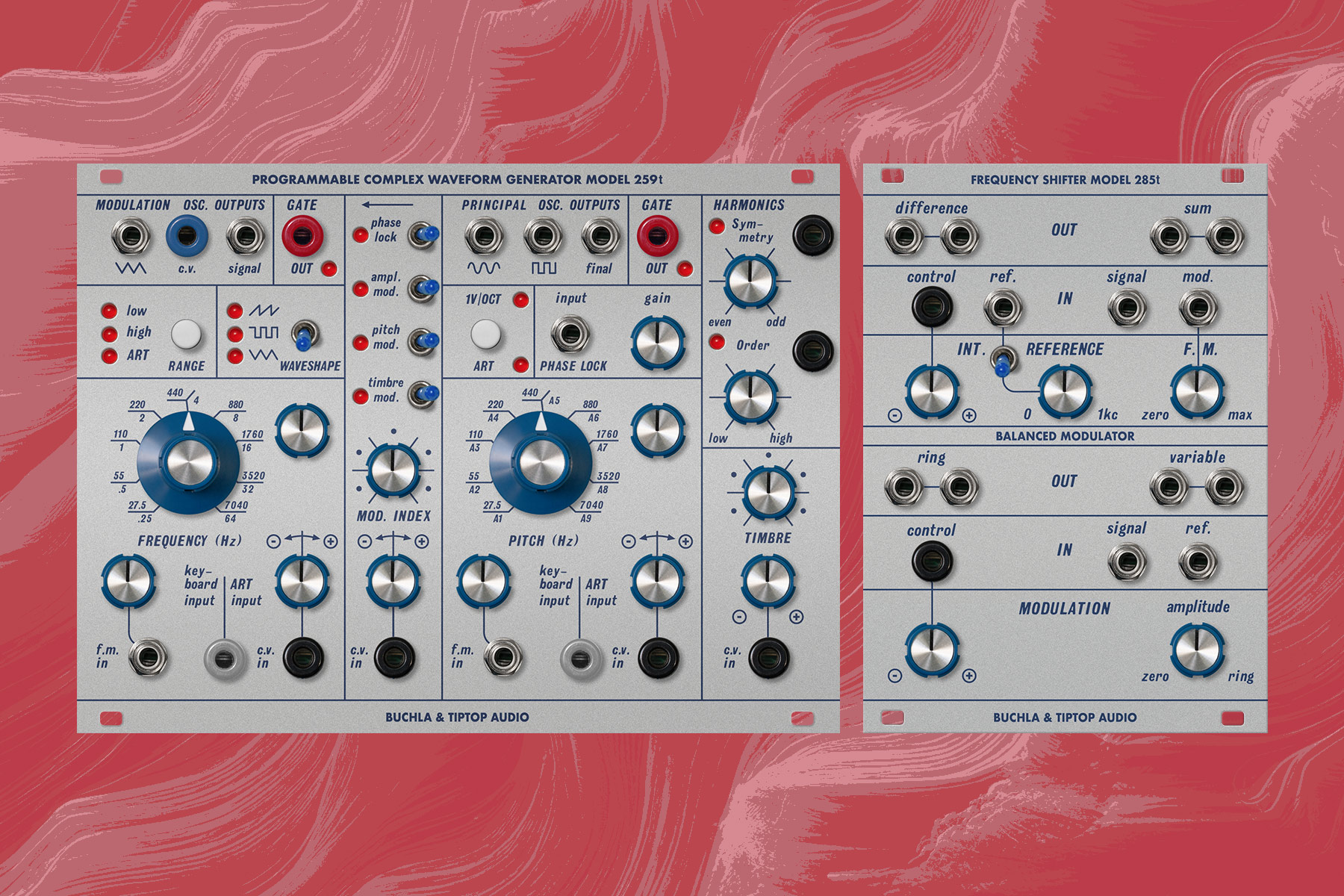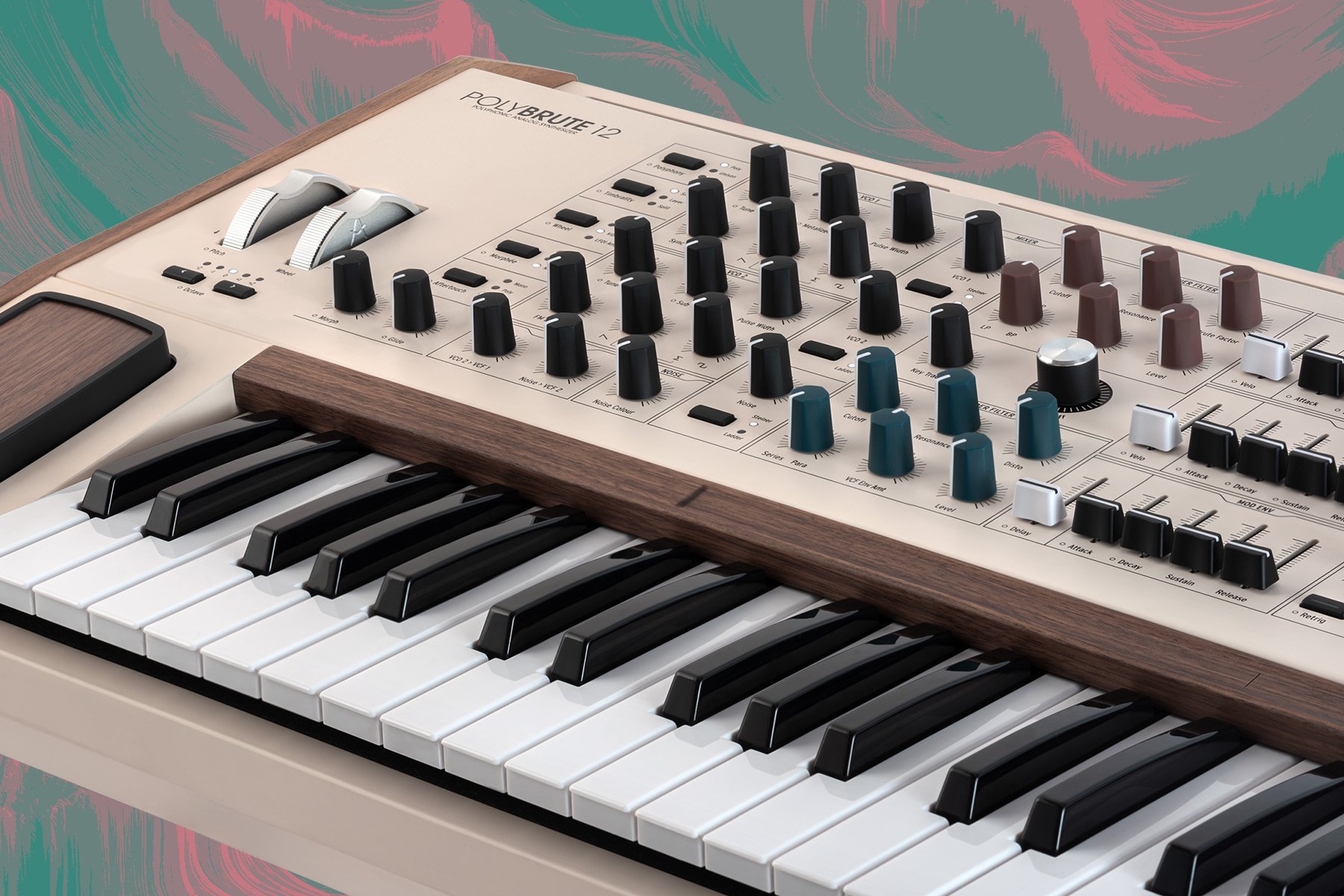We've thought it through, and decided it's true: there might not be an instrument quite so perfect as a keyboard synthesizer. A familiar playing interface combined with a progressive approach to sound design is a sure recipe for adventurous and inspiring sonic exploration—and happily, today there are more approaches to this time-tested instrument format than ever before. So if you're a keyboardist, studio owner, or producer looking to add a new keyboard synth to your setup, this guide is for you.
Our article Best Synths for Beginners goes through our favorite synthesizers under $600 specifically—so if you're looking for a synth on a budget, I'd strongly recommend giving it a read. In this article, we've expanded the scope to all keyboard synthesizers currently available; so the price range is a bit broader. It contains some truly cutting-edge instruments, some modern standbys for stage performers, and the occasional feature-packed budget-friendly instrument as well.
Of course, when we're looking at absolutely every synth out there, it also becomes necessary to establish some structure. As such, we've broken the article into sections based on instrument type. If you'd like to jump to a particular style of keyboard synth, feel free to use these links to jump ahead:
- Monophonic Analog Synthesizers: Bass, Lead and Effect Machines
- Polyphonic Analog Synthesizers: Modern Approaches to Classic Tones
- Digital Synthesizers: Groundbreaking to Sound Design & Expression
- Hybrid Synthesizers: Combining the Best of Analog and Digital
- Honorable Mentions: Synths We Couldn't Resist Mentioning
Each section features some of our staff's favorite instruments, demo videos, and more—so, read on to find out what synthesizer might be the next thing for your studio.
Monophonic Analog Synthesizers
Some of the earliest keyboard synthesizers were monophonic: from gargantuan 1960s modular systems to the venerable Moog Minimoog and well beyond. While that might have seemed unnatural at first—after all, shouldn't a keyboard be able to play chords?—the monophonic synthesizer has become its own unique entity: a category of instrument with its own unique repertoire, performance possibilities, and more. And of course, while many polyphonic synthesizers can be operated monophonically, we find there's something special about instruments that commit to being able to play a single note at a time. Often, designers embrace this limitation and use it as the framework to build something fascinating and unique.
In this section of the article, we're going to talk about two of our favorite machines for making heavy analog basses, searing leads, and richly-designed sonic textures: the Moog Subsequent Series and the Novation Bass Station II.
Evolution of the Monosynth: Moog Subsequent 37 + Subsequent 25
For many synthesizer fans, the "ultimate" analog synthesizer is a Moog. Robert Moog and his company indeed are one of the proverbial giants on whose shoulders many synthesizer manufacturers firmly stand to this day. While modular synthesizers and theremins were the hallmarks of Moog's output upon the brand's inception, it is in particular, the release of Minimoog Model D in 1970 that set the brand into the synth-maker stardom. The Minimoog is undoubtedly responsible for outlining the general shape of keyboard synthesizers to come, and simultaneously it played a defining role in the process of ingraining the sound of a (subtractive) synthesizer in our collective cultural memory. And while you can, of course, obtain a new Moog Model D today, we'd like to turn your attention to some of Moog's other offerings.
The modern-day "Sub" series, the Subsequent 37 and Subsequent 25, represents decades of improvements on those early synthesis concepts. This manifests in everything from the beloved slanted panel design of the instrument to features that emerged in the brand's later iconic instruments such as Voyager, Little Phatty, and Sub Phatty. Like the latter, the Subsequent series pairs a classic subtractive analog synth voice architecture with a powerful and precise digital control system—allowing MIDI connectivity, preset memory, sequencing, and more.
While there are certain differences between the two Subsequent models aside from the number of keys, it can be said that both occupy the same niche in Moog's current line of instruments. Both feature two variable waveform oscillators, a dedicated sub-octave oscillator, a noise source, and a mixer to blend the sources. Of course, the instruments include Moog's signature transistor ladder filter (with adjustable slope), and the aggressive multidrive circuit. The modulation section is one aspect where the two Subsequent models diverge: 25 sports a single LFO, and two ADSR envelopes, while the 37 is equipped with two LFOs, and a pair of more complex DAHDSR envelope generators. Additionally, if having a sequencer and arpeggiator integrated into your synthesizer is important to you, then definitely go with Subsequent 37. If, on the other hand, you prefer to outsource melodic control to external hardware and software, Subsequent 25 is as capable sonically, and its smaller footprint may be a much more welcoming feature for certain scenarios (small studios, traveling).
Both models are well equipped for interconnecting with a variety of other gear. They feature a headphone output, an audio signal input, 5-pin DIN and USB MIDI I/O, and four 1/4" control voltage inputs (amp, pitch, filter, and Gate). It is also important to note that, although the Subsequent 25 and 37 are unquestionably excellent at everything one might want from an analog monosynth, they still offer a bit more thanks to the paraphonic functionality. Only two notes can be played at the same time, yet it is still a much-welcome feature that can be indispensable in some situations.
With the recent reissue of the original Model D, Moog's current roster presents a number of variations on subtractive monosynths. Yet while these instruments are unified by a core idea, they all are quite different from each other. Grandmother and Mother-32 present a flexible semi-modular format that is well-adapted to experimental applications, while the aforementioned Minimoog presents an opportunity to explore the classic instrument in all of its original glory. The Subsequent models hence hold a very special place here—they act as a pinnacle of the brand's definition of analog monosynth. Presently, on the evolutionary trajectory of such instruments, Subsequent 25 and Subsequent 37 represent the latest stage. They are it.
Your Basses are Covered: Novation Bass Station II
With the original Bass Station released in 1993, and the second revamp hitting its tenth anniversary this year, the instrument unshakeably remains one of the best analog monosynths on the market. Importantly, since the release of the original, Bass Station was always intended to be an affordable synth, and it respectfully stays such today.
Bass Station II features a fairly common analog monosynth signal path, with the added benefit of extensive digital control. A pair of wide-range DCOs with a selection of four waveforms, a dedicated beefy sub-oscillator, a spunky multi-mode filter with selectable 12 or 24 dB/octave slopes, as well as a couple of ADSR envelopes and LFOs, have remained at the core of the instrument across its multiple incarnations. Yet, Bass Station II also arrived with a set of new features including a built-in sequencer and arpeggiator, a new "Acid" filter type, and as revealed in a later update, paraphonic functionality. Another peculiar feature of BS-II is the inclusion of a ring modulator connected to the outputs of the two main oscillators, offering yet another way to create gnarly complex wave shapes.
However, there is something else awesome about the Bass Station: its continued support and development. Novation has committed to extending the lifecycle of this instrument, keeping it constantly fresh by periodically releasing firmware updates that add drastic enhancements. One such instance is the overlays, feature which was added in 2020 as part of the AFX Mode update (co-developed with Richard D. James, aka Aphex Twin). Overlays allow you to map a decidedly different sound to each of the Bass Station's 25 keys, as such transforming the instrument into a capable drum machine or a sound effects lab. Fancy features aside though, it is obvious that if a company decides to spend so much time and effort on upgrading a nearly decade-old instrument, this signifies that much about that instrument has been done right in the first place.
On top of the instrument's excellent set of features, and rich sonic potential, it is important to outline how intuitive it is in operation. So if you cherish immediacy, Bass Station will not disappoint. All in all, the instrument's positives overweigh any potential negatives (say you're not a fan of a plastic enclosure or you wish it had more keys), and so, if you are on the lookout for a good analog monosynth, and prefer to not spend a fortune on one, Bass Station II will most likely exceed your expectations.
Polyphonic Analog Synthesizers
Of course, sometimes a single note or two isn't enough to do the job. Polyphonic analog synthesizers are still a unique breed: after their inception in the mid/late 1970s, they had a quite short lifespan, with most analog polysynths going out of production by the mid/late 1980s. Recently, though, a resurgence of interest in analog synths altogether has resulted in some amazing developments—and today, there are tons of polyphonic analog synthesizers in production at a wide variety of price points, each presenting their own unique take on this classic instrument concept.
In this section of the article, we're looking at a number of current instruments. We'll start with Sequential's -6 series (excellent instruments for gigging musicians or studios) and the Arturia Polybrute (a decidedly modern take on the analog polysynth concept). From there, we'll turn our focus to the Sequential Prophet-5 and Prophet-10 (classic synthesizers recently brought back into production), the Oberheim OB-X8 (a completely new take on several classic Oberheim instruments), and the Moog One (perhaps one of the most complex and multi-faceted analog instruments ever built). Let's go.
Practical + Powerful: Sequential's Power Trio
Sequential's offerings are extensive, but they've covered a lot of ground with their line of modern analog polysynths. Between the Prophet-6, OB-6, and Trigon-6, there's a good chance that Sequential has an instrument with the sound that you're looking for. Of course, these all have their own sound palettes, but they also have a lot in common: dual stereo effects engine, four-octave keybed, arpeggiator, polyphonic sequencer, and more!
Embodying Sequential's own classic sound, the Prophet-6 builds on everything that the classic Prophet-5 offered, but with numerous enhancements, additional features, and modern enhancements. Six voices of real analog VCOs, separate resonant lowpass and highpass filters, and flexible PolyMod routing all tied into a knob-per-function interface. This is the Prophet to choose if you're looking for that classic sound and workflow but seek a little more convenience and flexibility.
Developed in partnership with Tom Oberheim, the OB-6 harkens back to Oberheim's SEM oscillators and filters. Packed with two bright and bold VCOs and the superb state-variable filter, OB-6 has a sound that demands to be heard in a mix or within an ensemble. And with the continuously variable filter mode (and the ability to modulate this via X-Mod routing), OB-6 excels at far-out, spacey pads and the like.
The latest addition to the bunch, Trigon-6 covers the luscious sound of Moog-like synthesizers, but in a tight polyphonic package. Trigon-6 packs in three analog VCOs in each of its six voices, routed together through a thick resonant lowpass ladder filter. Through PolyMod and classic Minimoog-style tricks like using oscillator three as an LFO, the abundance of modulation sources leads to interesting opportunities for grit and chaotic feedback. Or, just slightly detune all oscillators from each other and engage unison mode for the fattest Moog-y lead you've ever heard.
Modern Analog Poly Masterpiece: Arturia Polybrute
Arturia's flagship synthesizer, the Polybrute, is an analog centerpiece that makes a statement visually and sonically.
It's flexible and versatile, just as capable of creating straight-forward leads and bass sounds along as it is highly complex and expressive patches. Using the built-in ribbon controller and unique Morphée 3D touch controller, you can easily evolve a pad or morph dramatically between two different sounds. Overall, it's perfect for the studio or stage, or any other time you need a reliable expressive instrument.
With six voices of analog polyphony with two VCOs each, a bevy of sounds are open to you: from harsh lead stabs using VCO1's Metalizer control, to warm bass sounds courtesy of VCO2's Sub octave control. Not only do you have two VCOs per voice, but two Filters as well. The Steiner multimode filter seamlessly blends between low pass, high pass, and band pass, and also feature's Arturia's famous Brute control for a bit of feedback/distortion. A Ladder filter delivers classic 24dB low pass, liquid sounds with high resonance and a built-in Drive control for added grit. The best thing is, though, is that you don't have to choose which oscillators go where: both can go to both, either, or neither filter, and the filters are capable of running in series or parallel.
Playable and customizable, the built-in gesture recorder lets you create the perfect imperfection in your patch and insert your own motion to any parameter. For more automated parameter control, the Modulation Matrix can assign modulation sources to any parameter. Features aside, though, the Polybrute just feels good: the keyboard is effortlessly playable, the interface is well placed, and with the optional wooden legs, your Polybrute can look like the finely crafted piece of equipment it is.
Classic Analog Poly Revisited: Sequential Prophet-5 + Prophet-10
Classic synthesizers are desirable for a reason, and sometimes the first product from a young company hits it out of the park, right out of the gate. In the case of Sequential Circuits and the Prophet-5, this is exactly what happened—and it set the standard for the designs of nearly all polysynths that came after it. And now, the Prophet-5 is available once again, and it's better than ever.
While it might not have been the very first polysynth ever created, the Prophet-5 certainly might have been the first to do it elegantly. Sequential Circuits had the benefit of being located in Silicon Valley, and by leveraging Dave Smith's knowledge of microcontrollers—new technology in the 1970s—the Prophet-5 was the first polyphonic synthesizer that could store and recall presets to/from digital memory. The Prophet-5 then went on to be used in music by the likes of Madonna, Radiohead, Vangelis, and so many more, establishing its dominating presence in the history of music.
Now, over 40 years later, Sequential is producing the best version of the Prophet-5 yet. The best circuits of the original remain perfectly in tact, but a few modern additions elevate the Prophet experience. From the option to select between two different filters used in earlier revisions to the Vintage knob that dials in the inconsistencies found in antique instruments, this Prophet-5 is the most flexible iteration yet. Truly, the Prophet-5 Rev4 is perfect for those who won't settle for anything less than the real deal.
Classic Analog Poly Reimagined: Oberheim OB-X8
There are plenty of ways to honor the legacy of iconic and classic instruments in new products, from digital recreations to authentic reissues. But in the case of Oberheim's OB-X8, another great approach is to design something new that encapsulates not just one, but three beloved synthesizers in one machine. If you're a fan of the sounds that the OB-X, OB-Xa, and OB-8 tracked onto countless hit records, this is the synthesizer for you.
Because the OB-X8 has to cover the sounds of three heavy-hitting synths all on its own, you're presented with plenty of options to craft the patches that you need. Beginning with SEM-style oscillators, OB-X8 offers two different types of filters: SEM filters as found on the OB-X, and the Curtis filters as found on the OB-Xa and OB-8. With the Type button on the OB-X8's front panel, you can easily toggle between the character that fits the mood best, and even explore previously inaccessible filters like highpass, bandpass, and notch with the "Page 2" menus.
Scrolling through the OB-X8's presets, you'll find all of the classic Oberheim sounds, from thick and heavy basses to squelchy and chirping filter-swept leads. In fact, the OB-X8 includes all of the factory presets from the OB-X, OB-SX, OB-Xa, and OB-8, along with some new sounds combining elements from all of the above with new tricks packed inside. It's practically a living encyclopedia of Oberheim sounds, and the OB-X8 offers the privilege of picking and choosing your favorites whenever you want.
The Future of Analog Polysynths: Moog One
The Moog One is very possibly the most luxurious analog synthesizer of our time. A fully polyphonic analog synthesizer with up to three simultaneous timbres, One is something like a 21st century Memorymoog: a no-holds-barred polyphonic instrument based on classic Moog-style signal architecture. In a marketplace primarily driven by attempts to provide as many features as possible at as low a price point as possible, instruments like One are rare...but there's certainly still a place for them. It seems as if Moog were simply trying to make the most complete and powerful instrument they possibly could without concerning themselves with price—and while that means that Moog One certainly isn't cheap, we believe it's fair to say that it is Moog's biggest feat of engineering to date. And in fact, we're fairly confident that it will go down in musical history as one of the most interesting synthesizers of all time. Not only is it a technical marvel...it also sounds incredible to boot.
One is available in both eight-voice and 16-voice variants—which, given its multi-timbral capabilities (splits, layers, and more) is a godsend. Polyphony count aside, though, each version is identical...so let's look at some of the highlights of how One works, starting with the oscillators.
One's three oscillators all feature continuously variable waveshape—with a mix control that allows you to blend between pulse and triangle or saw shapes. Furthermore, the pulse shape has variable width and the triangle and saw shapes offer "wave angle" controls, which provide a tilt-like function for continuously variable waveshaping. Oscillators two and three can also be hard synced, and all oscillators offer dedicated modulation controls for wave angle, pulse width, pitch, and more via the extensive mod matrix. One also includes audio-rate FM, a flexible ring modulator, and a noise generator which allows for continuous variation of noise color and its own amplitude envelope.
The mixer allows you to combine all the oscillators, noise, ring mod, and external audio input, as well as assign them to the two per-voice filters. The Ladder Filter is a modern version of Moog's classic transistor ladder design, which offers selectable slope and classic cutoff and resonance controls (all the way up to self-oscillation). Unlike many ladder filter implementations, it also allows for both lowpass and highpass modes, which is super cool. The State Variable Filter provides a unique sonic flavor, and allows for cutoff and resonance control, selection of highpass/lowpass/bandpass/notch responses, and control of whether the filters are routed in parallel or in series...great for all types of sound manipulation scenarios. But an extra special trick...the State Variable Filter is really two filters that allow for continuous control of cutoff spacing...so you can create formant effects/multi-band filter effects a la Voyager or Matriarch. It sounds wild. A dedicated filter modulation section makes common filter mod routings easy, but of course, all critical parameters are available as destinations in the mod matrix as well.
One offers dedicated filter and amp envelopes, as well as a modulation envelope. They're all identical, and quite similar to the Subsequent 37 described above: DAHDSR envelopes with optional latching and looping functionality. The LFOs are similarly flexible—there are four per voice (!), each of which offer multiple selectable wave shapes with shape variation parameters, frequencies up to 1000Hz, variable fade times, variable numbers of cycles (!), and much more. The mod matrix makes it easy to route a huge number of source to a huge number of destinations—and the super simple front panel layout makes it very easy to create modulation routings using dedicated front panel controls alone. The mod matrix also allows for amplitude controllers and "transforms" on each modulation slot, for complex dynamic alterations of your modulation signals.
Naturally, the signal path alone is only a fraction of what One can do. It offers per-timbre sequencing and arpeggiation, the ability to disconnect keyboard control from any given timbre, a remarkable effect section developed in conjunction with Eventide, routable audio outputs, and so much more. If your studio needs one of the most flexible, cutting-edge analog synthesizers of all time, One is likely to hold that title for years to come.
Digital Synthesizers
Naturally, the sounds of analog synthesis aren't the right tools for every occasion. If you're going for nostalgic, warm tones, then they're great...but sometimes, bending the rules of how sound should work is a preferable approach. So if you need something that makes sounds you've never heard, perhaps looking toward a digital synthesizer would be a better choice. With sound production capabilities limited only by their designers' imaginations, digital synthesizers provide a way to achieve tones that would never be possible with analog synthesis...and often, they can provide new means of interaction, to boot.
In this section of the article, we're looking at some of our favorite digital synthesizers. First, we'll look at the ASM Hydrasynth family, which provide a streamlined approach to progressive sound manipulation. We'll then scope out the new Expressive E Osmose, a design which places experimental new methods of control and interaction at the forefront. From there, we'll look at Waldorf's flagship instruments Quantum and Iridium, which each make a plethora of synthesis methods available simultaneously, and finally, the Nonlinear Labs C15, a hand-made, boutique instrument with a highly experimental approach to sound design and interaction.
Shapeshifting Secret Weapons: ASM Hydrasynth Family
We've written a lot about the ASM Hydrasynth family in the past, and for good reason: in so many words, they're some of the best synthesizers available in any price bracket. There are four models of Hydrasynth available, all using the same sound engine and more or less identical feature sets: the original 49-key keyboard version, the Hydrasynth desktop module, the Hydrasynth Explorer (a compact keyboard version), and the Hydrasynth Deluxe, which packages two identical Hydrasynth sound engines into a single keyboard for extended polyphony and bi-timbral support. Form factor aside, though, they're all nearly identical to one another, so as we present our thoughts going forward, remember that we're describing all models.
All right—you've probably seen and heard a lot about these instruments in the past couple of years...but let's briefly recap. What makes the Hydrasynth such a special instrument?
First things first...the Hydrasynth sounds excellent and can cover a tonof sonic territory, making it a great fit in nearly any scenario in which a synthesizer is needed. Though it is a digital synthesizer, it'll stand up against even the priciest analog synthesizers when creating classic pads, leads, basses, and more: it has some of the best virtual analog modeling available today. But where the Hydrasynth really shines is in the areas that branch away from traditional approaches to synthesis. Two key examples can be found in the oscillator section: two of the three oscillators for each voice can be set to "wavescan" mode, in which you can continuously morph between a list of eight selectable waveshapes. This parameter can be modulated with any of the internal modulation sources, making it an amazing way of creating timbral evolution over time. Another really powerful sound design tool are the "mutants": four waveshaping processors which can drastically alter the timbre of oscillator 1 and/or 2 for each voice (with two "mutants" in series on each of these oscillators). These allow everything from FM, sync, and pulse width modulation to considerably more complex types of sounds—chaotic feedback, pulsating timbral evolutions, wavefolder-like behavior, swarms of detuned tones, and much more. Best of all, each of the four mutants can be set to a completely different algorithm: tons of room for variation and exploration.
From there, the signal travels through some truly wonderful virtual analog filter models, with two unique filters per voice. Filter 1 offers selection from a large number of filter types (classic synth filter models, lowpass gates, vowel filters, and boutique modular filter models all represented). Filter 2 is a more SEM-style filter, continuously blending between HP/notch/LP or HP/BP/LP states. After the VCA, the sound passes through not one, but four effect processors: in order, a multi-mode effect (modulation effects, distortion, EQ, compression, and more), a multi-algorithm delay, a multi-algorithm reverb, and then finally another identical multi-mode effect (with independent algorithm selection).
The Hydra's modulation and expressive potential are also formidable. Each voice features five LFOs and five looping DAHDSR envelopes, each of which include some quite complex features. The LFOs support user-definable shapes and can even be treated as rudimentary sequencers for pitch or modulation; the envelopes can loop an arbitrary number of times; the envelopes can be triggered by the LFOs—the list goes on. The 32-slot modulation matrix and eight macro control slots make it easy and very quick to set up complex modulation schemes. And, lest I forget—one of the finest points of each Hydrasynth is that they natively support polyphonic aftertouch: they all include polyAT-capable keyboard/playing interfaces, and it's easy to assign aftertouch to dang near any parameter on the instrument. There's also a lot to be said for the arpeggiator—but in the interest of moving on, we'll save that discussion for another day.
Add MPE support for external controllers, and make independent versions at a variety of price points that don't sacrifice any sound programming power? In our opinion, the Hydrasynth isn't just one of the best synths currently available...it's one of the classiest synths ever made.
New Dimensions in Performance: Expressive E Osmose
Excluding niche modular synthesizers and other instruments, the piano-style keybed is by far the most common interface for playing a synth. Barring a few slight differences in feel and performance, the keyboard has remained largely unchanged across 50 years of synthesizer design. But with Osmose, the folks at Expressive E reimagined the keyboard from the ground up, translating clever 3D gestures into useful musical expression.
Osmose is packed with numerous sensors, capable of tracking even the smallest movements of each key and transmitting incredible amounts of continuous data. Tap, press, and shake notes with incredible dynamics and nuance, inspiring new ways to play and interact with your favorite sounds. Dig into the various degree of pressure and polyphonic aftertouch to add swelling textures. Nudge a key from side-to-side to incorporate pitch bends per-note, or explore pressure-portamento to glide between two held notes. Even with all of the above considered, Osmose remains approachable and performable.
In partnership with Haken Audio, Expressive E have included the EaganMatrix sound engine from the Continuum Fingerboard inside of Osmose. Shipping with over 500 presets, Osmose can cover traditional synth sounds like analog leads and FM pads, but also extends into organic physical modeling and strange granular synthesis techniques. Of course, it connects to other synthesizers, too, but don't dismiss the sounds of EaganMatrix—it's the perfect match for an instrument as potentially expressive as Osmose. For those looking to get more out of their playing with a synthesizer or explore the less-traveled paths of synthesis, Osmose is an exciting opportunity to dive into new sonic worlds.
Digital Flagships: Waldorf Iridium + Quantum MK2
Waldorf's flagship keyboards, the Iridium and Quantum, are quite similar to one another…with the main differences being: the Iridium is all digital with 16 voices, and the Quantum MK2 is instead a hybrid design with, again, sixteen voices (but the addition of eight analog filters). The software driving the two, however, is identical—with wavetable, waveform, particle (sample/granular), and resonator "oscillator" options available. Across three oscillators, many sounds are able to be conjured using a combination of these various synthesis methods. The internal granular and sample processor, however, is enough to power a full patch, with plentiful parameters and loads of potential for modulation. Additionally, both Iridium and Quantum are bi-timbral...capable of splits, layers, and multi-channel MIDI operation for truly lush, dense, layered sounds.
It's a rarity to see so many different types of synthesis housed in a single instrument let alone to have them all available simultaneously. And that is what makes these particular instruments so special: they present a streamlined interface for combining types of sound design/manipulation that are rarely used in conjunction with one another. Heck, granular and resonator algorithms are a rarity in keyboard synthesizers altogether.
Using the screen is a treat, with its ample pixels and touch response, however, all options on the screen can be accessed using the encoders that surround the screen. The layout on the two is a bit different, but with the attention to detail that Waldorf has placed on the interface, navigating your way around is not difficult. Filters are where the two do differ, but both can offer up to three filters at once—two are dedicated filters, and their Digital Former section has analog modeled filters along with distortion, bitcrushing, and other tools for sonic mangling.
Both synths are, most importantly, fun to use—while there is a learning curve like all instruments, this one is not too bad…and with the factory samples, you won't even have to worry about loading your own sounds in unless you want to. You can easily get lost in the endless void of space using the Iridium or Quantum. Second only to an actual computer, these are incredibly powerful, versatile, and luxurious sounding synthesizers that can be the centerpiece of a studio, and versatile enough to bring on stage. It's also worth noting that Iridium is available in desktop format, a great choice for anyone limited on space.
A Handcrafted Boutique Oddity: Nonlinear Labs C15
Of course, much of the promise of digital synthesis and sound design is that, with the right programming, you can create a sound structure that doesn't play by the traditional "rules" of how synthesizers should work. To an extent, the Hydrasynth, Osmose, and Waldorf synthesizers mentioned above do venture into novel territory in terms of synthesis structure—but I can think of one synthesizer that perhaps goes a bit farther: the Nonlinear Labs C15.
The C15 is a special type of instrument: hand made in small numbers by a small team, and conceptualized by a single designer: Stephan Schmitt, the founder of Native Instruments. Based on a synthesis concept of his own design (originally called Phase 22), the C15 focuses on phase modulation, feedback, and a deep integration of human interaction in order to create tremendously unique cinematic tones. Eschewing basic synthesis concepts such as LFOs (yep), the C15's focus is on direct human interaction...in fact, for years after its initial introduction, it didn't even have MIDI connectivity because Schmitt so wanted users to play the instrument. Eventually, MIDI was added to the feature set—but in Schmitt's defense, the instrument feels amazing to play, and truly feels alive in a way that is quite difficult to achieve with a digital instrument. Aftertouch, extensive implementation of velocity control, two large front-panel ribbon controllers, multiple expression pedal inputs...the C15 is just a joy to play, in a way that's difficult to articulate.
C15 is a bit too complex/unique to explain in full here...I'd recommend checking out our full article/review from 2020 in which we discussed its pros and cons. I will say, however, that if you're looking for a rich, deep instrument that produces remarkably expressive and complex tones, the C15 should not be overlooked.
Hybrid Synthesizers
But then, as evidenced regarding the aforementioned Quantum, it's quite possible to have your cake and eat it, too. It's become increasingly common for synthesizers to feature both analog and digital components: hybrid designs that combine the progressive sound design possibilities of digital synthesis with the warmth and character of classic analog tones.
Let's take a look at Arturia's Minifreak, a new and quite affordable instrument for exploring the intersection of analog and digital. We'll then check out the Sequential Pro 3, a fully-featured paraphonic synth that feels like a modular without the patch cables. Finally, we'll move onto the UDO Super 6, a Roland-esque synth with a novel approach to binaural sound design, as well as the Novation Summit, a bi-timbral synth with a lot of tricks up its sleeves.
Affordable and Gnarly as Heck: Arturia Minifreak
Arturia's MiniFreak is their affordable, portable, digital/analog hybrid synth that boasts features that would be at home in synths that cost twice as much. This thing just sounds good, there's no need for floral language: it's fantastic. Based on ideas first explored in their surprisingly affordable and downright wonderful Microfreak, the Minifreak boasts six full voices of polyphony, with digital oscillators, analog filters, digital effects, a mechanical keyboard, and even an animated graphic of an exploding frog (poor guy).
With Minifreak, you get two digital oscillators that have 22 different modes, including the option for complex sounds by using oscillator 2 to process oscillator 1. Classic waveshapes are present, but so are FM options, a speech mode, formant, modal, Karplus-Strong, and it goes on. Algorithms originally designed by Mutable Instruments and Noise Engineering offer state-of-the-art tones straight from the greatest minds in modular synthesis, while the analog filters—low pass, high pass, and band pass—make this a particularly juicy sounding synth, adding that touch of warmth to any sound.
The Mod Matrix combines fixed destinations for the most common parameters with three assignable destination slots, perfect for adding subtle or extreme movement. The built-in sequencer and arpeggiator modes offer playable options via the Spice, Mutate, Repeat, and Ratchet options. Two touch strips offer you standard Pitch/Mod Wheel controls, as well as sequencer/arpeggiator real time manipulation options, plus the option to freely assign three different destinations to each of the two strips.
Simple in its design, but capable of true complexity, the MiniFreak is one of the best affordable synths…and its sheer variety of sound options will leave you exploring for days. Its price is a mere tenth of some others on this list…but we think that it (and the identically-priced Hydrasynth Explorer) are honestly some of the best synths you can get at any price.
The Wildest Monosynth You've Ever Seen: Sequential Pro 3
As the name of the instrument may reveal, Pro 3 comes from the well-adored lineage of Sequential's instruments like the Pro-One and Pro-2. Like the latter two, it is a monosynth, yet functionally and sonically it far surpasses all of the common expectations of what "monosynth" should mean. For one, it is a hybrid design, skilfully blending the best of the analog and digital realms. Secondly, it features an unusually robust integrated control system. More still, the synthesizer stacks an array of high-quality effects that can be as useful for subtly adding a dimension to the tone, as for facilitating drastic sonic alterations and transformation. So what is the Pro 3 made of?
The synthesizer's voice structure sports a peculiar blend of oscillators: two variable-waveshape analog VCOs and a digital wavetable oscillator with wave morphing functionality. This combination alone makes Pro-3 capable of a range of tones most other monosynths could never reach. By default, the oscillators are set to stack in unison, but that can be changed by engaging the paraphonic mode. The oscillators, however, are not the only elements that contribute to Pro 3's extended tonal abilities. The instrument provides a selection of three highly distinctive filters: a Prophet-6-inspired 4-pole OTA low pass, a Moog-style 4-pole transistor ladder filter, and a 2-pole state-variable design borrowed from OB-6. After the filter, the signal is passed through the VCA, and then to the effects section filled with a variety of sound processing options including delays, reverbs, flangers, phasers, and rotary effects.
Sequential also didn't hold back on internal modulation and performance aspects of the instrumen. Pro-3 boasts three LFOs and four envelopes with looping functionality. It also has an arpeggiator, and an impressively full-featured 16-track sequencer with frills like ratcheting, and clock division/multiplication. Finally, it is important to underline the Pro-3 is dressed with connectivity options to impress. USB and DIN MIDI I/O, and four CV inputs and outputs allow the instrument to be easily integrated into any kind of setup.
As you can see, Pro-3 comprises an uncommonly potent conglomeration of modules and features for a monosynth, and to make it all work, Sequential equipped the synth with an insanely comprehensive 32-slot modulation matrix. So, with a total of 171 potential destination points, nearly every parameter on Pro-3 can be modulated and/or sequenced, facilitating a superbly wide range of sonic outcomes. Synthetic percussion—easy. Roaring leads or walls-shattering basses—flavors galore. What about lush pads, and evolving soundscapes—Pro 3 is fully capable of those too. Clearly, Sequential managed to realize an instrument that many synth fans could only dream of in the past. It fully lives up to its flagship status.
Vintage Roland Vibes + Binaural Swarms: UDO Super 6
Super 6 is the debut instrument from the UK-based manufacturer UDO Audio, and when first introduced, it instantly won our hearts and ears. From its stylish early-'80s Roland-esque look to the uniquely opulent sonic character, Super-6 is bold evidence that UDO-Audio takes synthesizer-making seriously. The company describes it as a 12-voice polyphonic binaural analog-hybrid synthesizer, and naturally, such a comprehensive definition requires some explanation.
Let's start by addressing the elephant in the room—what does binaural mean here? Well, dimensionality is one of the most important aspects of the Super-6's sound, and the company approached it in a very imaginative way. The instrument can operate in one of two modes: standard polyphonic or binaural. In the first mode, the position of each voice in a stereo space is associated with a note played—slight panning in the lower range, and it increases as the pitch goes higher. In the binaural mode, the twelve voices get equally split between the left and right channels (hence the name of the instrument). This then opens up the instrument to a set of very special stereophonic effects like stereo spreading and stereo filtering. Binaural mode, rather easily, allows you to create sounds that are rich and enveloping.
Now, that we are familiar with the binaural quality of the Super-6, it is time to further investigate the multitude of its other parts. The hybrid nature of the instrument is established by the mixture of powerful FPGA oscillators, and a warm SSM2040 analog filter. It also includes a pair of envelopes (HADSR and ADSR) and two LFOs, one per voice, and another global one. The instrument's two main oscillators, DDS1 and DDS2, while working jointly, diverge in functionality within the instrument's hierarchy of modules. DDS2 features a dedicated tune knob, allowing its pitch to be slightly offset in relation to DDS1. Furthermore, its range switch allows the oscillator to be dropped to the sub-audio territory, effectively acting as an additional per-voice LFO. DDS1, on the other hand, is equipped with a "Super DDS" switch, a mode that multiplies sixfold the oscillator count per voice…thus unveiling a wealth of highly moldable super-shapes. Yet more, aside from the classic waveforms included by default, custom wavetables can also be uploaded and further "superfied" within DDS1. The instrument also hosts a collection of effects that can further enhance and accent the tone first carved with filters and oscillators. Combined with the binaural mode, this opens up a decidedly novel sonic realm.
Presently, Super-6 exists in two forms: keyboard and desktop. Released first, the keyboard version features a high-quality 49-key Fatar keybed with velocity and aftertouch, as well as an expressive two-axis bender with an LFO trigger. Both versions, however, are equipped with an integrated arpeggiator and sequencer, making a selection between one or another simply come down to a question of space. All in all, while Super-6 may be inspired by vintage Roland instruments, it feels and sounds distinctly like a modern instrument, in the best possible way.
Two Peaks in One: Novation Summit
It is impossible to talk about Novation Summit without even a brief mention of the brand's other instrument—Peak. After all, Summit inherently is a synthesizer dreamed up on the premise of two Peaks combined. So what is Peak then, and what makes it so special that merging two is totally justified?
In essence, Peak is a desktop 8-voice polyphonic synthesizer, remarkable for its strikingly lush sonic character. Novation released the instrument in 2017, and its popularity has steadily grown since. A hybrid, Peak comprises three digital FPGA-based Oxford/New Oxford oscillators, a mixer with additional noise and ring-mod channels, a distinctive analog multimode resonant filter, a pre-, and post-filter drive, three AHDSR envelopes, two LFOs, an analog distortion circuit, and a set of high-quality onboard DSP effects. Peak also sports an integrated arpeggiator, and uniquely two Animate buttons useful for inflicting momentary or lasting changes to the sound. From the get-go, Peak proved to be a one-of-kind instrument, one that particularly excels at evolving and pulsating stereo soundscapes, but is perfectly capable of any other kind of sound. And now there is more of it.
Summit elaborates on Peak's established design. The general voice architecture and contents of the instrument are unchanged, however, Summit offers twice as much of it. The synthesizer features a 16-voice polyphony, as well as several multitimbral modes. You can split its keyboard into two parts, each assigned to a separate sound layer, you can layer two sounds on top of each other, or you can address each layer on a separate MIDI channel which allows totally independent control over each layer. Another important improvement in Summit is the inclusion of several crucial controls directly onto the panel of the instrument. Among them are dedicated FM knobs for each oscillator, and loop on/off switches on envelopes. While this may seem minor, it significantly improves the workflow with the instrument, making it much more immediate.
On the hardware side of things, Summit's connectivity options are abundant—including USB and DIN MIDI ports, CV input, 2 expression pedal inputs, a stereo audio input that allows you to use the instrument's effects for processing external sounds, two stereo outputs, and a headphone output. All in all, Summit is an exemplary instrument with a very distinct character. Like Peak, its general vector gently stirs you toward creating lavish ambient textures, and dense symphonic pads, yet like Peak, it is as easily capable to follow you to any other sonic realm. The power is there.
Honorable Mentions
Of course, a list like this is never complete. In this final section of the article, we're going to include quick mention of some of our other favorite synthesizers that, for one reason or another, didn't feel like the quite fit elsewhere on the list.
Access's Virus was a revolutionary synthesizer when it was first released, and it has consistently stayed at the top of the line when it comes to digital instruments. It ushered in the era of virtual analog synthesis and has constantly delivered insane sounds ever since. It is currently available in several formats: from the Virus TI2 desktop to the TI2 Polar compact 37-key keyboard and the 61-key TI2.
With an outstanding 20–90 voices possible across three oscillators with selectable waveform, the Virus is capable of just about any sound. You're not limited to normal waveshapes either: of course you can get the classics, as well as hyper-saw, but you also have wavetable, graintable, and formant shapes. Use the multi-timbral feature and load up to 16 patches simultaneously(!), accessible via MIDI channels 1–16 for luscious sounds, or plan out your performance with a variety of options.
Sound sculpting is second-to-none, with 129 parallel effects able to run simultaneously, you don't have to be limited to waveshape stacking. Use delay, reverb, phaser, chorus, distortion, character, and EQ all simultaneously. Two multimode filters are available, which can be routed in series or parallel for maximum flexibility. Using the 6-Bank modulation matrix, you can send a modulation source to up to three destinations—and dang near all parameters are available as destinations.
Virus features flexible physical hardware options, with 6 balanced outputs along with a dedicated headphone output…which means that you can create a complex series of patches and route them to their own dedicated signal chain for further processing or multi-track recording. The Virus TI also features audio inputs to take advantage of their Atomizer for playable effects and real time audio manipulation. The Access Virus TI is one of the only (if not the only) 16-part multi-timbral synths on the market and has stood the test of time with its outstanding sound quality and easy-to-use interface. Even so many years after its introduction, it stands its own and is a blast to use.
It'd be impossible to write an article about great synthesizers without also mentioning Nord—who played a significant role in the birth of "virtual analog," and the re-introduction of fully-featured synthesizers into the marketplace altogether. Today, they make many types of instruments, from digital organs and stage pianos to new iterations of their Lead series of virtual analog synths...but I want to briefly mention another instrument: the Wave 2.
The original Nord Wave was one of the most groundbreaking instruments of its time...and the new Nord Wave 2 picks up right where the original left off. Wave 2 reimagines the original wave's signal architecture, providing access to virtual analog, FM, wavetable, and sample-based synthesis all in a streamlined, intuitive package. What's more, Wave 2 provides the ability to split/layer up to four distinct timbres, each of which can use any of those four aforementioned synthesis methods. Like the Iridium and Quantum above, this makes it possible to mix and match between sound worlds that are seldom combined...and with impeccable sound quality.
One of the Wave 2's strongest features is its sample engine. Allowing import of user samples and an enormous number sounds immediately available from Nord, you can truly make Wave 2 sound like anything you want. Heck, you could create multiple layers of samples that all play out simultaneously—creating crashing collisions of sound and dreamy sonic textures. Combined with the "morphing" concept, which allows the use of performance controls to enable macro-level changes to many parameters simultaneously, you have a sound design tool which has few if any equals. Plus, like all other Nord instruments, it makes a great stage instrument for the gigging musician...so if you're a keyboardist looking for a reliable instrument that fits into a ton of contexts (piano, organ, etc.) and provides you massive synthesis and sample-based sound design potential, there's nothing else quite like the Nord Wave 2.
And, naturally, we need to address one of the other quite significant synthesizer designers: Roland. Though Roland's primary focus has shifted toward instruments outside the world of synthesizers since their great instruments of the 1980s, they're still producing instruments that deserve attention. The most notable of their current designs are, perhaps, the Jupiter-X and Juno-X, each of which use Roland's ZEN-Core synthesis engine to evoke the sound and feeling of their classic instruments. Though they obviously evoke the look of vintage Jupiter and Juno models, respectively, they actually have a fair amount of sonic overlap: each offering sounds from iconic Jupiters, Junos, the XV-5080, and more. In fact, the Jupiter-X offers a dedicated drum engine that includes models of classic drum machine such as the TR-808, TR-909, CR-78, and others...so if you're looking for a fully-featured instrument that provides easy access to all the Roland sounds you know and love, it's easily possible.
This list could go on. There's no shortage of amazing instruments, and more are emerging every day—so if you want a full idea of what is out there, we recommend checking out our full selection of keyboards and synthesizers. While this list reflects our own favorites, it's quite possible the right instrument for you is still out there waiting.

